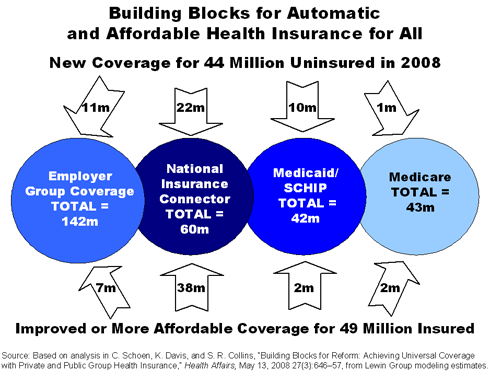Also see: The Building Blocks of Health Reform: Achieving Universal Coverage and Health System Savings and a Health Affairs commentary on universal coverage by Cathy Schoen.
In the Literature
The upcoming presidential election and ongoing primary races have brought health care reform squarely back into the spotlight. Despite a handful of statewide reform initiatives, the nation is losing ground on coverage and families are feeling the strain on their wallets and their health. But while the need for universal coverage is clear, there is a lack of consensus on how to provide and finance such an expansion.
Keeping What Works
The two core components of the "Building Blocks" framework—expanding Medicare and maintaining the current role of employer-sponsored insurance—are both in line with public opinion. As outlined by the authors, the plan would continue uninterrupted coverage for many insured people, while offering new options for small firms and individuals. "Through Medicare, the federal government is in the unique position to sponsor an insurance connector of national scope that would link public and private markets and pull together individuals and small groups."
Extending Coverage for All
Under Building Blocks, small businesses, the uninsured, and the self-employed could gain coverage through a new national insurance connector that would offer a choice of a Medicare-like option with enhanced benefits, called Medicare Extra, and private plans. The premiums for Medicare Extra would be community-rated for everyone under age 60, estimated at $259 per month for single premiums and $702 per month for families in 2008.
To help finance the plan, employers would be required—under a "play or pay" mandate—to offer coverage or pay a payroll tax of 7 percent of earnings, up to $1.25 per hour. Those employers offering coverage to employees would be responsible for at least 75 percent of the premium and plans would have to meet general minimum standards.
Low-income adults with incomes below 150 percent of the federal poverty level would be eligible for coverage through Medicaid and the State Children's Health Insurance Program (SCHIP), with premiums fully covered. Middle- and higher-income individuals could gain some financial relief through tax credits. Premium assistance through tax credits would be made available to ensure that premiums do not exceed 5 percent of income for lower-income households, or 10 percent of income for higher-income tax households.
To ensure participation, all residents would be required to provide evidence of coverage when filing their taxes. Individuals without coverage and incomes in excess of 150 percent of the poverty level would be automatically enrolled, with Medicare Extra as the default option. People with incomes under 150 percent of poverty would be enrolled in Medicaid or SCHIP.
Achieving Goals and Minimizing Costs
The benefits of Building Blocks are clear: The plan would achieve near-universal coverage, with 99 percent of the population participating. In the first year, the number of uninsured people would drop from an estimated 48.3 million in 2008 to 3.6 million, largely non-tax filers.
About 60 million people—mainly small-business employees, but also 14 million previously uninsured individuals and 1.2 million people who were insured in the individual market—would voluntarily obtain coverage through the national insurance connector. About two-thirds of this enrollment would be in Medicare Extra; the remaining individuals would be in private plans.
"The estimated net effect on total national health spending is minor," say the authors, with an increase of less than 1 percent, or $15 billion dollars, in 2008. Expenses related to covering the newly insured and providing improved coverage would be largely offset by lower administrative costs and a net reduction in provider reimbursements. Federal budget cost in the first year would be $81.7 billion.
The Building Blocks approach is a pragmatic one, say the authors, because it seeks to build and improve upon existing sources of insurance. At the same time, "it offers a pathway from the current fragmented insurance system to one that is more integrated and efficient."
To learn more about the estimated impact of the Building Blocks framework, combined with health system reform initiatives, on coverage, access, and costs, read The Commonwealth Fund issue brief, The Building Blocks of Health Reform: Achieving Universal Coverage and Health System Savings.



